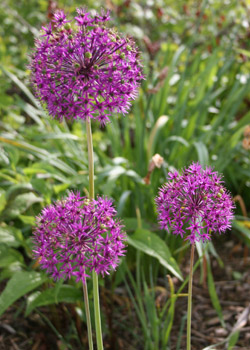Allium Bulbs Information

Allium, or flowering onions as they are sometimes called, are found in the same family as garlic, shallots, chives, and onions. Blooming in late spring to early summer, these plants will add an interesting texture to your garden with their often tall stalks topped by spherical blooms. Varieties range in height from 12 inches up to 4 feet at times. Rodents and deer do not desire to munch on bulbs grown in the onion family which means that allium bulbs are deer resistant! Dried Allium flowers also last quite a while and make wonderful arrangements.
Plant Information
- Planting Time: Fall
- Bloom Time: Late Spring
- Hardiness Zone: 3-8
- Suitable Zone: 3-9
- Light Needs: Partial - Full Sun
Planting Allium
- Allium are typically planted in fall. Their roots will form in fall and they will bloom in late spring.
- Choose a planting location that has well drained soil, and receives full to at least a half day's sun.
- The spacing for alliums typically ranges between 4" and 8". The bigger the bulb, the more space they will need. Alliums do not grow with a spreading habit, so they look better when planted closer together.
- The planting depth is going to differ depending on the variety you are growing. As a general rule of thumb, flower bulbs should be planted approximately 2-3 times their height in depth. For instance, Allium Giganteum (Giant Allium) often has a bulb which is 2-3" tall. This bulb should then be planted 6-9" deep into the ground.
- Plant bulbs "pointy end" up.
- Thoroughly soak the area with water once all of the bulbs have been planted. Water as needed while the plant is growing and blooming.
- Once the flowers begin to fade cut and dry or use for fresh cut arrangements. Allow the remaining foliage to yellow and die back. The leaves will continue to gather sunlight and make food for next year's blooms.
- Once the foliage has yellowed and dried, it may be removed by gently pulling it out of the soil. If the leaves do not easily pull away from the bulb, they are not ready to be removed. After the foliage has been removed, your allium will be dormant and ready to "rest" until next year!